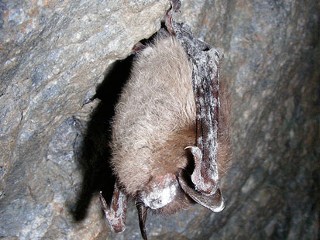
A spreading plague has killed more than a million bats across the eastern U.S., and wildlife experts have no clue how to stop it.
As it rolls across the country and into Canada, the mysterious fungus threatens to disrupt the ecological balance, which could result in the spread of bugs that destroy crops and force swatting barbequers to flee indoors.
Called White-Nose Syndrome because of the white substance found on the noses of bats, it causes bats to move around and burn calories during the winter months when they should be hibernating and reserving energy. Scientists are not exactly sure why the fungus affects bats, where it came from originally, or how to stop its spread. One thing is for sure -- bat populations are being decimated by the fungus. Among some bat species, the mortality rate is 99 percent.
"There might be regional extinctions of particular bat species," said Noelle Rayman, assistant national White-Nose Syndrome coordinator at the U.S. Fish and Wildlife Service, told ABCNews.com.
The parasite kills bats during the winter when they hibernate. It invades the tissues in their wing membranes and causes irritation that leads the bats to move around inside the cave when they should not, or even leave the cave in search of food during the cold winter months. All of this activity makes them deplete fat reserves that would normally allow them to hibernate through the winter.
"Essentially they're becoming emaciated and starving to death," Rayman said.
If bats continue to die in record numbers, entire ecosystems could be affected. Bats comprise one-fifth of the Earth's mammal species, not to mention they eat pesky bugs, including mosquitoes.
"Bats are the primary nighttime predator of insects and so they'll work to control agricultural pests, forest pests, human pests," Rayman said.
"They eat large volumes of insects - half their weight in insects in a night," Al Hicks, a bat expert at the New York State Department of Environmental Conservation, said. According to Hicks, a bat that weighed only 8 grams could eat 4 grams of insects every night.
Hicks estimates that half a million bats have died near Albany, N.Y., as a result of the disease. Those bats would have eaten roughly 2 million grams, or 2.2 tons of insects each night.
Though there are fewer bats to eat the insects, it does not necessarily translate to more mosquito bites, Hicks warned.
"They'll eat a mosquito if one flies in front of them," Hicks said. He noted that bats are not too concerned with what they eat.
"For us to notice anything, there would have to be a huge, huge difference in what's going on."
Dying Bats Once Ate Half Their Weight In Insects Each Night
Whether or not the effects can be seen among insect populations, the threat of the fungus is very real.
Hicks confirmed that a majority of the bats living near Albany have perished from the fungus.
Bats dying from the fungus have been found as far north as Quebec in Canada and as far south as Tennessee. Researchers have also identified the fungus in caves in Oklahoma, but no bats have been found dead there yet. It appears to be spreading farther from the northeast with each passing winter.
"The fungus itself is primarily spread through bat to bat transmission," Rayman said.
"Humans may be playing a role in transporting the fungal spores around as well."
Humans can carry the fungus on their clothing or gear if it is not properly cleaned after visiting a cave with the fungus, but Rayman said humans' role in spreading the fungus has been minor. People are not at risk for catching the disease. Regardless, state authorities and the National Forest Service have closed caves throughout the country to prevent the spread of the fungus.
Rayman said the fungus thrives in cold caves with high humidity. She is hopeful that climate will help limit the scope of the damage, but they are looking at other solutions to the problem.
Researchers at the U.S. Fish and Wildlife Service are trying to find a treatment that would kill the fungus and have allocated $2 million for research on White-Nose Syndrome. They are still evaluating research proposals for that grant money, and Rayman said they are cautious in their efforts to slow down or stop the fungus.
"We don't want to do more harm than good," Rayman said. "There is still a lot more that we need to learn."



Reader Comments
to our Newsletter